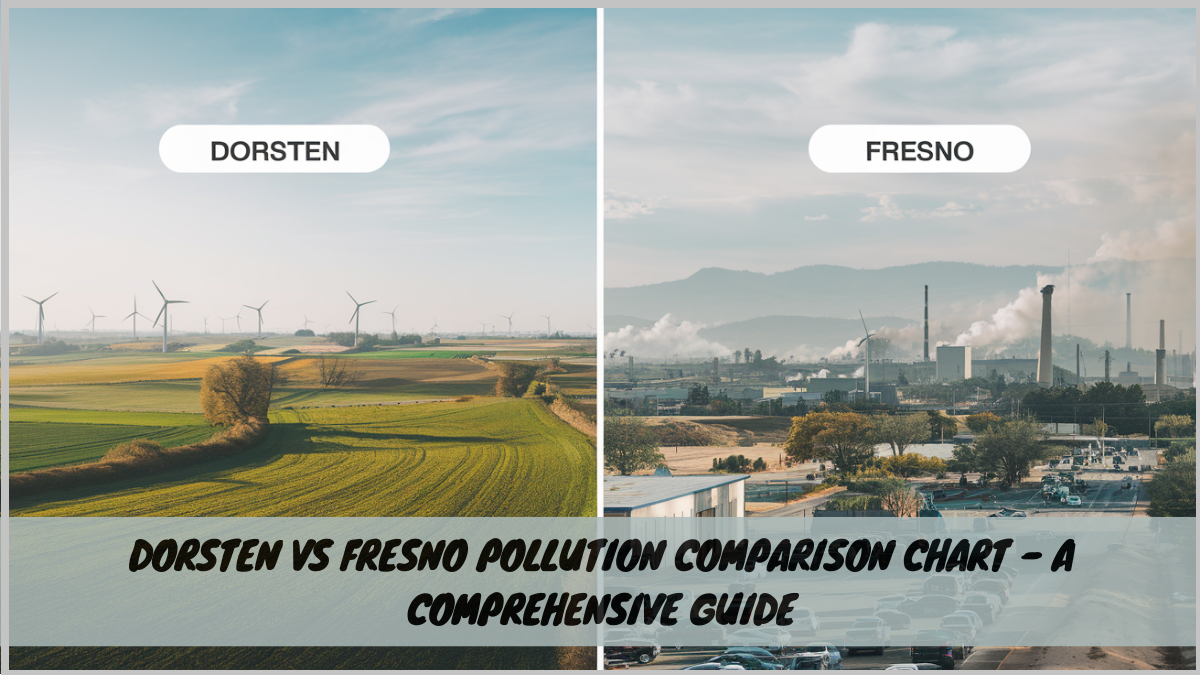Dorsten vs Fresno Pollution Comparison Chart: A Detailed Analysis
Air pollution is one of the most significant environmental challenges we face today. Cities worldwide are grappling with increasing pollution levels, impacting public health and quality of life. This article comprehensively compares pollution levels between two seemingly unrelated cities: Dorsten, a quaint town in Germany, and Fresno, a major city in California, USA. While they may be geographically distant, comparing their pollution statistics reveals essential insights into global environmental trends and the unique challenges faced by urban and semi-urban areas.
We will explore the air quality, significant pollutants, sources of pollution, and the overall environmental and health impacts these cities face. Through this Dorsten vs Fresno pollution comparison chart, you will get a clearer understanding of how air pollution affects these regions and what can be done to improve air quality.
Understanding the Pollution Metrics
Before diving into the comparison between Dorsten and Fresno, it’s crucial to understand the key metrics used to evaluate air pollution:
- PM2.5 and PM10: Particulate Matter (PM) is the most common air pollutant. PM2.5 refers to fine particles with a diameter of 2.5 microns or less, while PM10 refers to larger particles up to 10 microns. High concentrations of PM2.5 are hazardous as they can penetrate the lungs and even enter the bloodstream.
- Ozone (O3): While ozone in the stratosphere protects us from the sun’s harmful ultraviolet rays, ground-level ozone is a significant pollutant. It forms when pollutants from vehicles, factories, and other sources react with sunlight.
- Nitrogen Dioxide (NO2): A common pollutant from vehicle emissions, NO2 contributes to smog and respiratory issues.
- Sulfur Dioxide (SO2): Produced by burning fossil fuels like coal and oil, sulfur dioxide significantly contributes to acid rain and respiratory problems.
- Air Quality Index (AQI): The AQI is a measurement scale used worldwide to communicate how polluted the air is or is forecast to become. An AQI level above 100 is considered unhealthy.
Pollution in Dorsten
Dorsten is a small town located in North Rhine-Westphalia, Germany. As a part of the Ruhr region, Dorsten has an industrial history that affects its air quality. Although not heavily urbanized, the town still faces pollution due to its proximity to industrial zones.
Key Pollution Factors in Dorsten:
- Due to increased residential heating and industrial activities, PM2.5 and PM10 levels tend to rise during colder months.
- Traffic-related pollution is a significant contributor, especially with the presence of major highways.
- Industrial emissions from nearby facilities contribute to higher levels of NO2 and SO2.
Dorsten, however, benefits from strict European Union (E.U.) environmental regulations, which help control pollution levels. Programs aimed at reducing vehicular emissions and promoting cleaner industrial processes have made a noticeable impact.
Dorsten Air Quality Statistics (average yearly levels):
- PM2.5: 12 µg/m³ (moderate)
- Ozone (O3): 45 ppb (parts per billion)
- NO2: 30 µg/m³ (moderate)
- AQI: 50 (Good to moderate, depending on the season)
The pollution levels in Dorsten are manageable compared to larger cities in the region, but they still pose health risks, especially for vulnerable populations like children and older people.
Pollution in Fresno
Fresno, located in the San Joaquin Valley of California, has a well-documented air pollution problem. The valley’s geography traps pollutants, making Fresno one of the most polluted cities in the United States.
Key Pollution Factors in Fresno:
- Agricultural activities are a significant source of pollution. Fresno’s large farming industry contributes to PM10 levels due to dust from plowing and pesticide use.
- Vehicle emissions from traffic are a significant contributor to NO2 and ozone pollution.
- Wildfires, which have become more frequent in California, also severely impact air quality, dramatically increasing PM2.5 levels.
Despite state regulations aimed at curbing emissions, the combination of these factors and the valley’s bowl-like topography makes air pollution in Fresno a persistent issue.
Fresno Air Quality Statistics (average yearly levels):
- PM2.5: 18 µg/m³ (unhealthy for sensitive groups)
- Ozone (O3): 60 ppb (high)
- NO2: 35 µg/m³ (moderate to high)
- AQI: 85 (Moderate to unhealthy for sensitive groups)
Fresno frequently experiences “bad air days,” where the AQI exceeds 100, indicating unhealthy conditions for the general public.
Dorsten vs. Fresno Pollution Comparison Chart
PollutantDorstenFresnoSafe Limit (WHO)
PM2.5 (µg/m³) 12 18 10
PM10 (µg/m³) 20 35 20
Ozone (ppb) 45 60 50
NO2 (µg/m³) 30 35 40
SO2 (µg/m³) 5 8 20
AQI (average) 50 (good to moderate) 85 (moderate to unhealthy) Below 50
Health Impacts of Pollution in Dorsten and Fresno
Health Effects in Dorsten:
Although Dorsten’s pollution levels are generally lower than Fresno’s, they still pose health risks, particularly during winter when residential heating and industrial emissions increase. Prolonged exposure to moderate levels of PM2.5 and NO2 can lead to respiratory problems, cardiovascular issues, and aggravated asthma symptoms.
Health Effects in Fresno:
Fresno’s air pollution has far-reaching health consequences. The city’s high levels of PM2.5 and ozone lead to a higher prevalence of asthma, bronchitis, and other respiratory illnesses. Studies have shown that living in areas with high PM2.5 levels can reduce life expectancy. Fresno residents, particularly children, older people, and individuals with pre-existing conditions, are at greater risk.
Causes of Pollution: A Breakdown
Causes of Pollution in Dorsten:
- Industrial Emissions: Though Dorsten is not as heavily industrialized as other parts of the Ruhr region, nearby factories still pollute the air.
- Traffic: Car emissions, particularly diesel vehicles, are a significant source of NO2 in Dorsten.
- Residential Heating: During winter, the use of coal and wood for heating contributes to higher PM2.5 levels.
Causes of Pollution in Fresno:
- Agricultural Activities: Fresno’s farming industry produces large amounts of dust, contributing to high PM10 levels.
- Vehicle Emissions: With a large population and significant car usage, Fresno suffers from high levels of NO2 and ground-level ozone.
- Wildfires: Increasingly common wildfires across California exacerbate Fresno’s pollution problems, significantly raising PM2.5 levels for extended periods.
Environmental Regulations and Solutions
Dorsten:
Dorsten benefits from stringent E.U. air quality regulations limiting industrial plant and vehicle emissions. The town has also adopted several measures, including:
- We are promoting electric vehicles to reduce traffic-related pollution.
- Investing in renewable energy to cut down on coal and oil use for heating.
- Urban greenery initiatives that help absorb pollutants and improve air quality.
Fresno:
Despite facing severe pollution challenges, Fresno is actively working on solutions to improve air quality. These include:
- Regulating agricultural emissions: The state has limits on dust and pesticide use in agricultural fields.
- Vehicle emission standards: California has some of the strictest car emission regulations in the U.S., pushing for a shift to electric vehicles.
- Wildfire prevention and response: Efforts to manage forest health and reduce wildfire risks are critical to controlling PM2.5 spikes.
Final Thoughts: A Tale of Two Cities
While Dorsten and Fresno face different challenges regarding air pollution, both cities illustrate the global nature of the air quality crisis. Dorsten’s smaller population and strict regulations have kept pollution levels relatively low, though industrial and traffic-related emissions still pose a threat. On the other hand, Fresno’s unique geography, agricultural economy, and wildfire-prone landscape make air pollution a much more significant public health issue.
Questions and Answers:
- Which city has worse pollution, Dorsten or Fresno?
- Fresno generally has worse air quality, mainly due to higher levels of PM2.5 and ozone pollution, which often exceed safe limits.
- What are the primary sources of pollution in Dorsten and Fresno?
- Dorsten’s pollution primarily comes from industrial emissions and traffic, while agriculture, vehicle emissions, and wildfires drive Fresno’s pollution.
- Can anything be done to improve the air quality in these cities?
- Both cities are working on solutions such as reducing vehicle emissions, promoting green energy, and enforcing stricter pollution controls in agriculture and industry.



